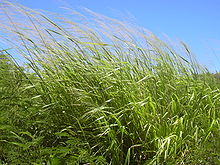- Megathyrsus maximus
-
Megathyrsus maximus 
Scientific classification Kingdom: Plantae (unranked): Angiosperms (unranked): Monocots (unranked): Commelinids Order: Poales Family: Poaceae Genus: Megathyrsus Species: M. maximus Binomial name Megathyrsus maximus
(Jacq.) B.K.Simon & S.W.L.Jacobs, 2003Synonyms Megathyrsus maximus, known as Guinea Grass or Green Panic Grass in English, is a large perennial bunch grass that is native to Africa Palestine, and Yemen. It has been introduced in the tropics around the world.[1] Due to its wide distribution, it has common names in a large number of languages and dialects. The specific name, maximus, means largest in Latin.
Description
Megathyrsus maximus grows naturally in open grasslands, usually under or near trees and shrubs and along riverbanks. It can withstand wildfire and drought. The species has broad morphological and agronomic variability, ranging in height from 0.5 to 3.5 m (1.6 to 11 ft), with 5–10 cm (2.0–3.9 in) stems.[2] Panicles are open, with as many as 9000 seeds per plant.
Uses
It can be used as a long-term pasture grass, if grazed consistently. It is well suited for cut-and-carry, a practice in which grass is harvested and brought to a ruminant animal in an enclosed system. Shade tolerance makes it suited to coexisting with trees in agroforestry. Some varieties have been used successfully for making silage and hay. The leaves contain good levels of protein (13-21%).
- Invasive species
In some places it is considered an invasive weed that suppresses or displaces local native plants.[3]
References
- ^ a b "Megathyrsus maximus (Jacq.) B. K. Simon & S. W. L. Jacobs". Germplasm Resources Information Network. United States Department of Agriculture. 2007-06-25. http://www.ars-grin.gov/cgi-bin/npgs/html/taxon.pl?447623. Retrieved 2010-01-07.
- ^ Panicum maximum at Tropical Forages
- ^ Guinea Grass at Sungei Buloh Nature Park
Categories:- Poaceae
- Bunchgrasses of Africa
- Flora of Africa
- Flora of Palestine
- Flora of Yemen
- Plants described in 2003
- Invasive plant species
- Forages
Wikimedia Foundation. 2010.
